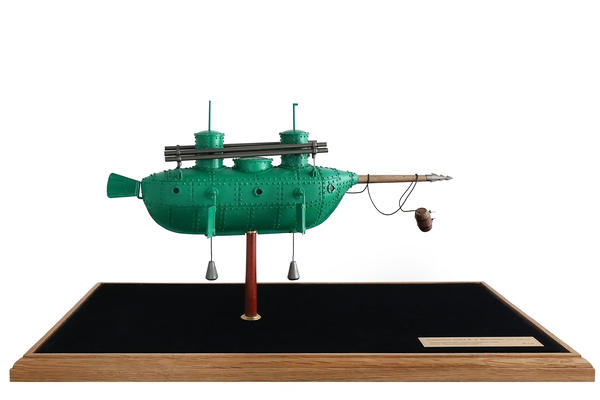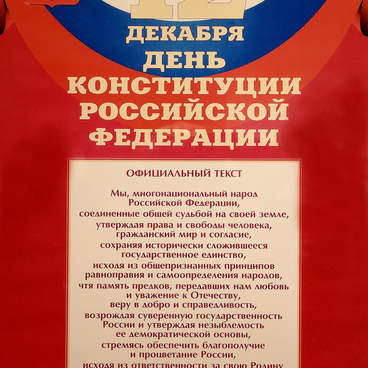The exposition features the model of a submarine designed by engineer Carl Schilder in the spring of 1834. The hull of the submarine was assembled at the Alexandovsky Iron Foundry. The armament and equipment were made in the workshops of the Imperial Guard of the sapper battalion, and the rockets - in the St. Petersburg Rocket Institution.
Works on improving the submarine dragged for several years. The final tests were held in September 1840 between Petrovsky and Krestovsky islands in St. Petersburg. The boat submerged to the maximum possible depth and remained in this position for 3 hours with only the tops of the submarine towers visible on the surface. The dive was successful. According to the team, they did not feel any “tightness of air”.
The subsequent tests of the submarine were carried out according to the program the Committee on Submarine Experiments developed together with Karl Schilder himself. As a result, the Committee decided that the submarine was not suitable for combat, as it could not chart the right movement course under water. Further experiments with Schilder’s submarine were deemed unproductive.
Carl Schilder was born near Smolensk in 1785 and graduated from the Moscow Noble University Boarding School. In 1803, he was accepted to the service in the Depot of the quartermaster unit as a column leader - that is, the one who leads the military column.
The Battle of Austerlitz was the first major battle which Schilder took part in. A year later, in 1806, he joined the engineering forces, where he served until the end of his life. He was promoted to the rank of Adjutant General at the end of his career.
Schilder was not only a talented draftsman and surveyor, but also an inventor. The engineer tested a variety of attack and defense techniques, developed designs of underwater mines and submarines with all-metal hull.
Schilder also developed his own training system for engineers. Among the successful specialists trained according to his methodology was General Eduard Totlebe for example.
A friend of Schilder’s, scientist Pavel Schilling, discovered a method of gunpowder.electric ignition. Schilder applied the invention to develop the electric detonation system for underwater mines. The engineer ran the first public test of his mines in 1834 on the Obvodnoy Canal and it was a success.
Emperor Nicholas I acknowledged the talented scientist’s merits. When Schilder died in the Danube campaign of 1853 - 1854, the emperor wrote: ‘The loss of Schilder made me extremely sad; there will be no other one like him, either in terms of knowledge or courage.’
Works on improving the submarine dragged for several years. The final tests were held in September 1840 between Petrovsky and Krestovsky islands in St. Petersburg. The boat submerged to the maximum possible depth and remained in this position for 3 hours with only the tops of the submarine towers visible on the surface. The dive was successful. According to the team, they did not feel any “tightness of air”.
The subsequent tests of the submarine were carried out according to the program the Committee on Submarine Experiments developed together with Karl Schilder himself. As a result, the Committee decided that the submarine was not suitable for combat, as it could not chart the right movement course under water. Further experiments with Schilder’s submarine were deemed unproductive.
Carl Schilder was born near Smolensk in 1785 and graduated from the Moscow Noble University Boarding School. In 1803, he was accepted to the service in the Depot of the quartermaster unit as a column leader - that is, the one who leads the military column.
The Battle of Austerlitz was the first major battle which Schilder took part in. A year later, in 1806, he joined the engineering forces, where he served until the end of his life. He was promoted to the rank of Adjutant General at the end of his career.
Schilder was not only a talented draftsman and surveyor, but also an inventor. The engineer tested a variety of attack and defense techniques, developed designs of underwater mines and submarines with all-metal hull.
Schilder also developed his own training system for engineers. Among the successful specialists trained according to his methodology was General Eduard Totlebe for example.
A friend of Schilder’s, scientist Pavel Schilling, discovered a method of gunpowder.electric ignition. Schilder applied the invention to develop the electric detonation system for underwater mines. The engineer ran the first public test of his mines in 1834 on the Obvodnoy Canal and it was a success.
Emperor Nicholas I acknowledged the talented scientist’s merits. When Schilder died in the Danube campaign of 1853 - 1854, the emperor wrote: ‘The loss of Schilder made me extremely sad; there will be no other one like him, either in terms of knowledge or courage.’



